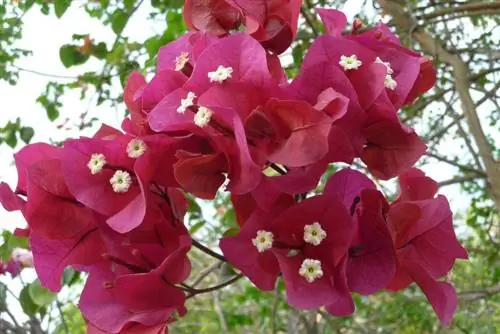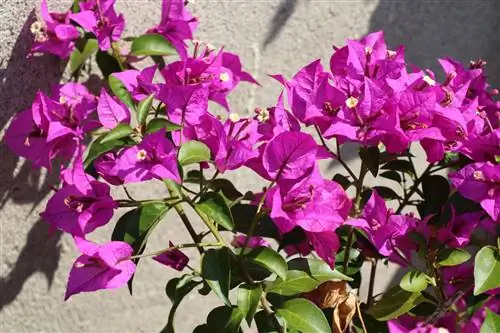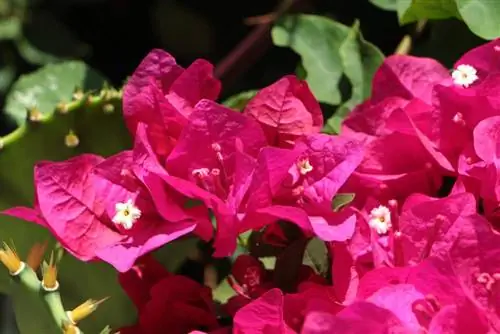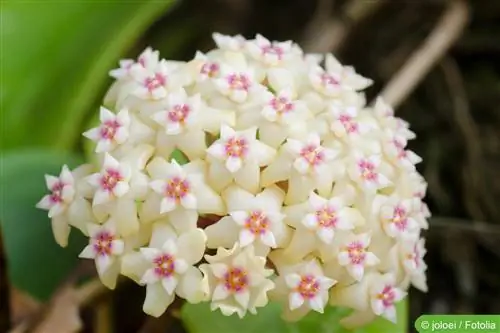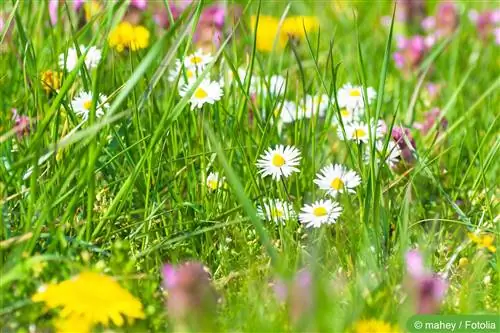- Author admin [email protected].
- Public 2023-12-17 03:39.
- Last modified 2025-06-01 06:48.
The Bougainvillea glabra is probably the uncrowned world record holder: no plant grows faster to create a lively flower decoration. One blossom next to the other, in every shade of red from soft pink to dark purple, in every shape from a small bush with dense flowers to a climbing “flower miracle on the facade”. The most important basis for this top performance is a warm, sheltered outdoor location where the tropical plant can capture every ray of sunshine in the German summer. Of course, the hard-working plant also has some demands, below you will find out what care will satisfy the Bougainvillea glabra:
Bougainvillea care profile:
- Bougainvilleas come from tropical climates and, above all, need a lot of light
- That should fall on the plant in an outdoor location in summer
- If you can't offer this location, you don't need to buy bougainvillea
- It will hardly bloom then, among the green climbing plants there are simpler ones
- In the right location you could experience the ultimate floral splendor
- The care has to be right, but it can be done (even for beginners)
- Requirement No. 2 of the fast-growing flower miracle: A sufficiently large pot right from the start
- The rest of the care is basically simple, you just need a little attention and care:
- Always enough water, but never wet feet, enough nutrients for lush growth, the basic needs are met.
The tropical bougainvillea needs special locations
Bougainvillea glabra developed in South America, the core area of coastal states in Brazil. Under a tropical sun that burns more intensely all year round than here in summer. The bougainvillea is warmer there all year round than here: “Tropical” means that the temperatures do not fall below 20 ℃ at night. This is how it is in the Brazilian homeland of Bougainvillea glabra, the daytime temperatures are somewhere between 25 and a good 30 ℃ all year round, and seasonal temperature differences are hardly noticeable.
Bougainvillea glabra is not doing so well for us. First of all, a look at its homeland shows that a Bougainvillea glabra can only be kept as a pot plant because it has to spend the winter protected in a guaranteed frost-free interior.
Then a look at the Brazilian homeland of Bougainvillea glabra also shows that we cannot grow it as a potted plant in the room, but really only as a container plant. The pot plant culture in the classic meaning of the word differs from the culture of a “normal house plant” (which can also grow in a pot of a size that can rightly be called a pot) in one feature that is also important for the culture of bougainvillea: The pot is intended as a large planter (usually equipped with wheels) to be placed outdoors in summer.
A bougainvillea in this climate absolutely needs this summer stay outdoors - where it should be in full sun for as long as possible (based on the day and the season) - if it is to develop the plant parts for which you You acquire: Enchanting flowers in an impressive size of up to 7 cm ∅ and above all in an almost unbelievable abundance, with the Bougainvillea glabra the extravagant flower shape with three neat triangles and a colorful firework of color contribute to the stunning overall effect of the “floral design”. "at. And you can enjoy this floral design for an extraordinarily long time because in reality all the splendor does not come from the flowers (they are tiny and white), but consists of colored bracts. In contrast to delicate petals, these bracts have a really strong structure and last for weeks.
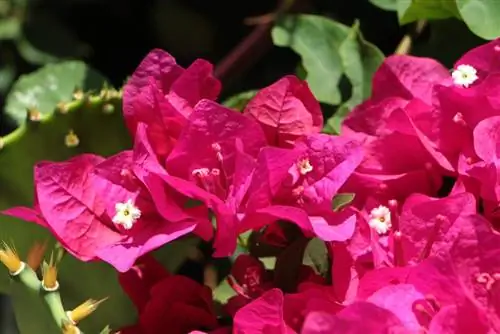
The outdoor location should be nice and warm and protected. The most beautiful sun is of little use if a cold wind constantly whistles around the corner and spoils the plant's mood (and growth). The place that is protected during the day should not turn into a "hell hole" at night, open to all weather and other influences “transform because e.g. B. a huge awning is retracted.
Lack of space?
Grow the Bougainvillea glabra in a climbing/hanging habit; you can find a warm, sunny spot for it anywhere. You then only have to attach enough hooks to distribute the flower tendrils decoratively over the balcony, terrace or facade.
Care - step by step
Once the outdoor location has been determined, the Bougainvillea glabra can be purchased and planted in its container. However, the Bougainvillea glabra already has some demands on this pot:
- Enough space from the start, the roots grow just as quickly as the rest of the plant
- Definitely a process below
- On top of this there is a drainage layer made of gravel or clay, which “absorbs” too much moisture
- The coaster must be checked regularly for residual standing water
- The waste water hole in the bucket should also be checked regularly and, if necessary, cut free
- If the roots are in water, the flowers would no longer look magnificent pretty quickly
- Use a good, fairly nutrient-rich substrate
- Depending on the surrounding situation, commercially available quality potting soil or a mix of garden soil + compost
- Do not repot during the season, even if the container is tight
- Repotting the sensitive roots could end the flowering season
- This narrowness is only supposed to encourage the bougainvillea to produce more (stress) flowers
Other care is pretty straightforward if you keep a careful eye on the individual care components:
- The triplet flower wants to be watered evenly and quite generously
- It doesn't like drought at all, no wonder given the huge plant mass that needs to be looked after
- The rhythm is perfect when you water the root ball with residual moisture
- Always add water when the top layer of soil in the pot feels dry
- Nutrients in the bucket have to be provided more by you than by busy soil organisms
- A lot of nutrients if a bougainvillea has decided to grow vigorously (which is the normal case)
- According to experience reports, a Bougainvillea glabra needs fertilizer in a normal concentration every month from the time it sprouts in spring
- When flowers appear, there is additional flower fertilizer (flowering fertilizer, flowering plant fertilizer)
- Also every month, but staggered by two weeks, and over the entire “flowering period” of the beautifully colored bracts
- It doesn't matter that the actual flowers have long since faded, the flower fertilizer contributes the nutrients to the development of strong colors
Tip:
" Sunny, warm, protected location", "water evenly and abundantly", "fertilizer about every 4 weeks in normal concentration" - information with a level of precision that drives beginners to despair in plant care. But it couldn't be more precise because every plant is an individual and the conditions are always different and the bougainvillea is a good teaching plant for beginners because it grows so quickly that the effects of every change in care can be easily understood. Don't be afraid, you just shouldn't start with the two meter high old plant for just under 1,000 euros.
Cutting
The Bougainvillea glabra is also the right plant for “design with lively flowers” in that the young plants can be trained in several forms:
- Climbing plant, very narrow and growing long or wide, but shorter
- Tall lush flowering shrub with multiple trunks
- High trunk with spherical crown
- Bougainvillea glabra, which you have grown yourself or bought young, grow into narrow, long climbing plants on their own
- They will be more wide if you force them to branch by trimming
- The fast-growing plants react so quickly that you can set the branches almost precisely
- A young bougainvillea grows into a flowering shrub if branching is stimulated by regular pruning
- Some branches form the framework and are allowed to grow unhindered
- It's similar with the standard tree, you only have to choose ONE trunk (and you have to be a specialist for that, the instructions for raising a standard tree would go beyond the scope of the article)
- Larger Bougainvillea glabra can be purchased in bush form or as a standard tree
- You have already completed basic cutting training and only need to be cut when necessary
- The shrub usually gets some contour all around in spring
- Not necessarily every spring, but would be recommended to maintain a dense, well-branched growth habit
- With tall trunks with spherical crowns, you have to work more often if you want to get clear contours
- These should be shaped by pruning at least once a month
- Not only forms the perfect ball, but also ensures that it branches ever more finely towards the outside
- When a bougainvillea has almost reached the desired maximum height, spring pruning should be more vigorous
- Resp. well in advance, one year's growth should be reduced by a maximum of half at the beginning of the next season
With all of these pruning measures, you have to be careful not to cut off any future flowers from the Bougainvillea glabra, which usually blooms several times in one season. The easiest way to achieve this is to make the first cut where the first bunch of flowers have just withered. This may mean cutting a fairly short shoot; It is exactly what it means because bougainvilleas bloom at the very end of the shoots.
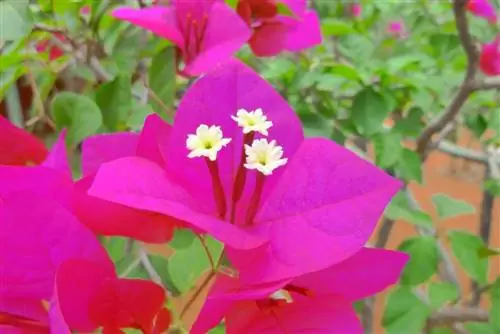
So you need to immediately create branching (=more short branches with more flowers at the ends) if you don't want to grow a long garland with individual flowers. The branching of the Bougainvillea glabra is pretty easy to plan: Where you cut off a new shoot (with light green bark), the Bougainvillea will start a new side branch, which will then produce a blooming flower after about 4 weeks. Maximum branching + maximum number of flowers results in the following cutting rhythm at 4-week intervals: Wait for the flowers to bloom, cut, wait for the branches to bloom, cut, wait for the flowers of the new branches, cut, etc.
Since each of these cuts is stressful for the bougainvillea, you can give it “a little sip of fertilizer” after each cutting to strengthen it.
The most beautiful varieties
with some really spectacular flower colors:
- 'Choisy' has been blooming with dark purple bracts since 1861, with good care throughout the summer without a break
- ‘Dania’ blooms double and blood red
- ‘Greetings from Badenweiler’ shows flowers in delicate pink
- 'Isabel Greensmith' blooms rose red
- ‘James Walker’ develops a strong scarlet color
- ‘Magnifica’ has large purple flowers
- 'Mini-Thai' grows small, compact, upright and flowers purple
- ‘Mrs. Butt' blooms scarlet red with a touch of purple
- 'Sanderiana' has had many large, light purple flowers since 1894 and grows weaker than the species
- 'Sanderiana Alexandra' is the name of the variant bred in 1950 with intensely purple flowers
- 'Sanderiana Elisabeth' blooms slightly brighter than Alexandra
- 'Sanderiana Variegata' crowns strong pink flowers with variegated foliage
- 'Snow flake' blooms snow-white
- 'Variegata' decided in 1889 to draw yellow stripes around yellow-green leaves, flowers red-purple
- 'Vera Deep Purple' features flowers in a pretty incredible pink
Tip:
Bougainvillea glabra produces lush floral displays in all shades of purple and red, from delicate pink to deep red and purple. However, the Bougainvillea genus includes 18 species, two of which are cultivated as ornamental plants. These Bougainvillea spectabilis and Bougainvillea peruviana are also available in several varieties that shine with magnificent flower colors. Hybrid breeding involving all three species adds further colors and double flowers - if you use the entire spectrum of bougainvillea, you can have the whole thing Incorporate the yellow-orange color circle into your color scheme, from almost creamy light yellow to dark orange-red with clear copper accents.
Overwintering bougainvillea
Bougainvilleas are usually cultivated as annuals because the overwhelming results of summer cultivation can be achieved with so little effort that the effort involved in overwintering a tropical plant is out of proportion.
Overwintering is said to be difficult for many of the cultivars sold in the mass trade, and many of the cultivars are said to be so short-lived that they only spread moderate joy in the following season - overwintering can be difficult for the average person -Bougainvillea, which is cultivated by people who have not yet taken a closer look at overwintering cold house plants, simply cannot be recommended in good conscience.
If you have fallen in love with the willing flower miracle (which would not surprise any bougainvillea fan), you can overwinter your specimen frost-free according to the rules for cold house plants and hope that you can repeat this a few more times. Above all, you should contact bougainvillea specialists in order to purchase a bougainvillea that is guaranteed to last. Especially with the Bougainvillea glabra, overwintering is definitely worth it because it becomes more and more beautiful over the years.

